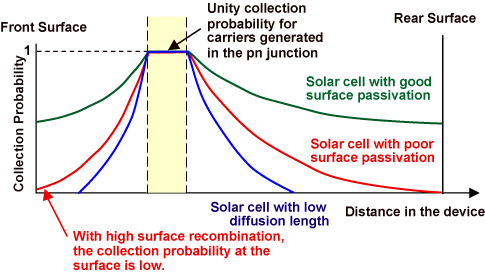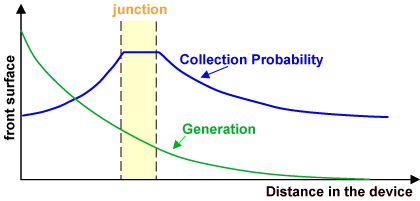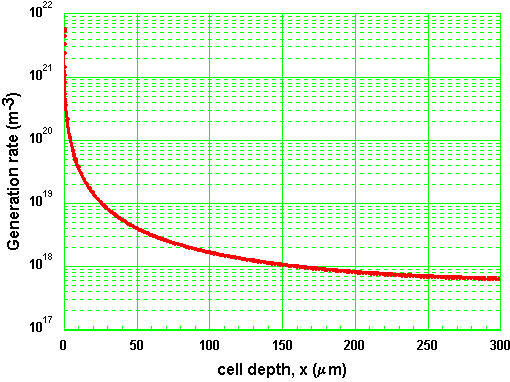The "collection probability" describes the probability that a carrier generated by light absorption in a certain region of the device will be collected by the p-n junction and therefore contribute to the light-generated current, but probability depends on the distance that a light-generated carrier must travel compared to the diffusion length. Collection probability also depends on the surface properties of the device. The collection probability of carriers generated in the depletion region is unity as the electron-hole pair are quickly swept apart by the electric field and are collected. Away from the junction, the collection probability drops. If the carrier is generated more than a diffusion length away from the junction, then the collection probability of this carrier is quite low. Similarly, if the carrier is generated closer to a region such as a surface with higher recombination than the junction, then the carrier will recombine. The impact of surface passivation and diffusion length on collection probability is illustrated below.

Calculation of the collection probability. The diffusion length in the emitter is in red and in the base is in blue. Ln denotes the minority carrier diffusion length and SRV is the surface recombination velocity. Click on the graph for numerical data.
Collection Probability and Optical Generation
The collection probability in conjunction with the generation rate in the solar cell determines the light-generated current from the solar cell. The light-generated current is the integration over the entire device thickness of the generation rate at a particular point in the device, multiplied by the collection probability at that point. The equation for the light-generated current density (JL), with an arbitrary generation rate (G(x))and collection probability (CP(x)), is shown below, as is the generation rate in silicon due to the AM1.5 solar spectrum:
$$J_{L}=q \int_{0}^{W} G(x) C P(x) d x=q \int_{0}^{W}\left[\int \alpha(\lambda) H_{0} \exp (-\alpha(\lambda) x) d \lambda\right] C P(x) d x$$
where:
q is the electronic charge;
W is the thickness of the device;
α(λ) is the absorption coefficient;
H0 is the number of photons at each wavelength.

The light-generated current depends on the generation of carriers and the collection probability of these carriers.
The generation profile in silicon due to the Am1.5 spectrum. Note that the carrier generation is the highest at the surface of the solar cell, thus making photovoltaic devices very sensitive to surface properties.
A non-uniform collection probability will cause a spectral dependence in the light-generated current. For example, at the surfaces, the collection probability is lower than in the bulk. Comparing the generation rates for blue, green and infrared light below, blue light is nearly completely absorbed in the first few tenths of a micron in silicon. Therefore, if the collection probability at the front surface is low, any blue light in the solar spectrum does not contribute to the light-generated current.
The creation of electron-hole pairs for different wavelengths of light in silicon. Blue light of 0.45 µm has a high absorption coefficient of 105 cm-1 and is therefore absorbed very close to the front surface. Red light at 0.8 µm and an absorption coefficient of 103 cm-1 is absorbed deeper into the cell. Infrared light at 1.1 µm with an absorption coefficient of 103 cm-1 is barely absorbed since it is close to the band gap of silicon.

